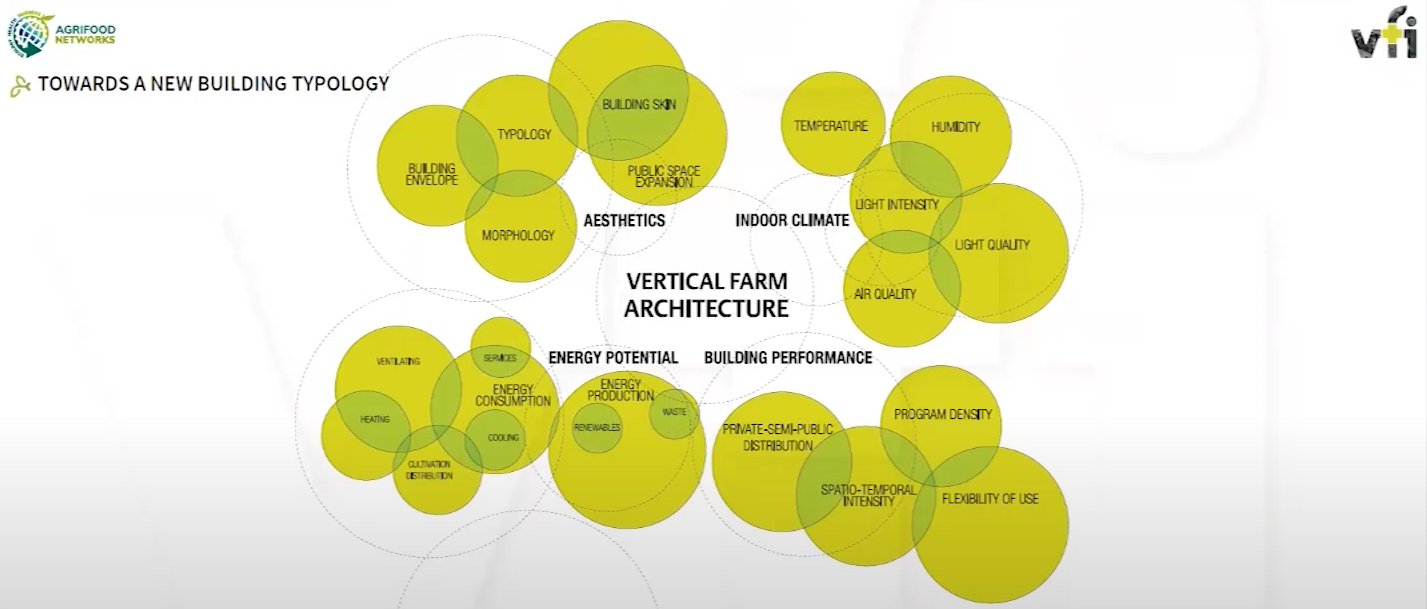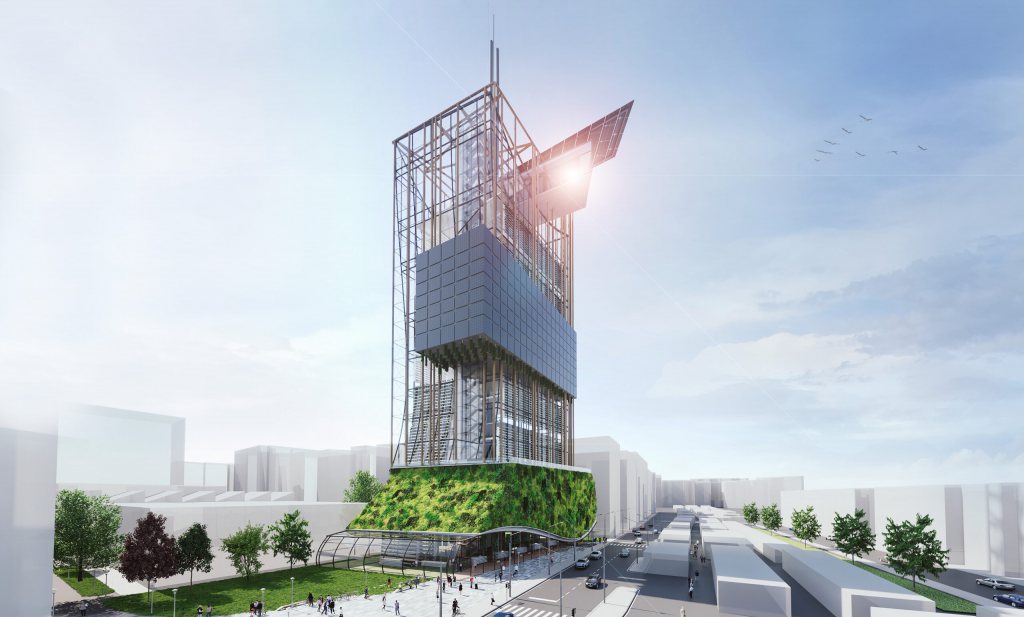"We need to think about how to radically increase urban food production." As stated by the CEO of the Vertical Farm Institute (VFI) Daniel Podmirseg during the Digital Food webinar "Vertical Farming". The VFI aims to provide sustainable solutions to the challenges facing traditional agriculture, such as land shortages, water shortages, and climate change, while also facilitating access to fresh and healthy food in urban areas.
According to the United Nations, the world's population will grow to 10 billion by 2075. "Is there enough land mass to produce the food needed to feed all these mouths?" asks Podmirseg. He explains that while there seems to be enough space, only 10 percent of the earth's land is actually suitable for agriculture and food production. This has to do with the Earth's biocapacity. Water, mountains, and forestation have rendered a portion of the earth's surface useless. Another area has poor soil health or is just too hot, cold, or dry. Of the limited usable land mass, about 1.5 percent of that 10 percent has become unusable due to soil erosion, deforestation and the changing climate, among other things.
Less dependency
The central question in the Digital Food webinars is how data and technology can help the world become more sustainable. The VFI focuses on research, development and the promotion of vertical farming technologies and systems and sees vertical farming as a prime solution.
Vertical farming stacks and grows crops in vertical structures, such as in skyscrapers, greenhouses or specially designed towers. The goal is to make traditional agriculture less dependent on energy and reduce the use of natural resources. By growing crops within controlled environments, they can optimize conditions for maximum yield, water and energy efficiency, and reduce the use of pesticides and herbicides.
Energy efficiency or scarcity?
Vertical agriculture is associated with high energy consumption. However, VFI believes vertical farming can contribute to the energy efficiency of cities. "Vertical farming cannot increase efficiency, but it can optimize it using digital tools," says Podmirseg. Based on simulations, VFI designs a vertical farm in which energy is used as efficiently as possible. This is preceded by mapping the food chain. He explains that the route from farmer to plate is shorter with vertical farming: virtually no energy is needed for transportation, distribution, processing and retailing. "But at the end of the day, we still have to cook the food and we consume energy."
To estimate energy efficiency, VFI analyzes not only food production but also the characteristics of the building in which the vertical farm is located. Consider the climate outside and inside, the presence of ventilation and windows to capture daylight. To optimize energy consumption, the topology of the building must match the growing conditions and energy requirements of the food products being grown there. Even though the media hype surrounding vertical farming seems past its prime, the VFI is convinced that the vertical farm will be the building design of the 21st century.
 Towards A New Building Topology, Daniel Podmirseg
Towards A New Building Topology, Daniel Podmirseg
The big question is whether vertical agriculture can contribute to the energy and food transition or whether it only produces luxury lettuce. A similar critical note comes from the audience. Is there enough energy to produce food in the city rather than in the countryside? Concerns already exist whether there is enough energy at all to produce enough food for so many people. Energy sources are depleting, fossil fuels are running out and the environmental impact is great. Recently, Professor Eddy Decuypere (KU Leuven) also expressed doubts about energy costs. According to Podmirseg, it is clear that changes are needed to reduce the consumption of scarce energy: "It is too late to be a pessimist." Still, energy consumption does not seem to him to be the biggest challenge in vertical farming.
Vertical farming must be done
According to Podmirseg, the challenge reduces if we change our diet: less meat and less dairy. But before that can happen, we have to start. The challenges of adopting vertical farming range from high energy consumption and technology limitations to lack of training and policies. Podmirseg is convinced that vertical farming is not a technological or energy issue, but a matter of political decisions to start and grow from there. "We cannot solve the problem alone. Reshaping the energy system for the good of a sustainable future requires cooperation, just like any other social problem. It takes courageous people who want to act, otherwise a sustainable city with its sustainable food system will remain a dream."
Currently, a land area the size of Sweden is still needed to feed LondonThe amount of land required to produce enough food varies by nation. The amount of agricultural land needed depends on population growth (the number of people), diet (what they eat), socio economic development (what do they have available to spend) and the degree of digitization (how optimal is the agricultural yield), among other factors. In Africa, for example, more land is needed for the same harvest because they lack advanced irrigation techniques. "Every 1m2 of a city needs up to 10m2 of agricultural land," Podmirseg estimates. "Look at a city like London. A land area the size of Sweden is needed to feed London," he states. That cries out for a radical change: more food must come from less land.
Less dependency
The central question in the Digital Food webinars is how data and technology can help the world become more sustainable. The VFI focuses on research, development and the promotion of vertical farming technologies and systems and sees vertical farming as a prime solution.
Vertical farming stacks and grows crops in vertical structures, such as in skyscrapers, greenhouses or specially designed towers. The goal is to make traditional agriculture less dependent on energy and reduce the use of natural resources. By growing crops within controlled environments, they can optimize conditions for maximum yield, water and energy efficiency, and reduce the use of pesticides and herbicides.
It is too late to be a pessimist. It takes courageous people who want to act, otherwise the sustainable city with its sustainable food system will remain a dream"We need to change our perspective in which buildings are usable for people to a perspective in which buildings are optimized for plant growth," Podmirseg said. The VFI contributes to the development of food production methods in existing buildings or war ruins. The institute investigates various aspects of vertical agriculture, such as lighting systems, climate control, irrigation techniques, growing substrates and crop selection. Therefore, multidisciplinary teams of scientists, engineers and agricultural experts are needed to develop new technologies and methods to improve the productivity and sustainability of vertical farming systems. Architects and economists also enter the mix to help the business model succeed. "This is where traditional agriculture, architecture and urban planning come together," Podmirseg states of the collaborations. The VFI aims to harness the benefits of vertical agriculture in the areas of food security, environmental protection and urban development.
Energy efficiency or scarcity?
Vertical agriculture is associated with high energy consumption. However, VFI believes vertical farming can contribute to the energy efficiency of cities. "Vertical farming cannot increase efficiency, but it can optimize it using digital tools," says Podmirseg. Based on simulations, VFI designs a vertical farm in which energy is used as efficiently as possible. This is preceded by mapping the food chain. He explains that the route from farmer to plate is shorter with vertical farming: virtually no energy is needed for transportation, distribution, processing and retailing. "But at the end of the day, we still have to cook the food and we consume energy."
The VFI is convinced that the vertical farm will be the building design of the 21th centuryGrowing different products has different energy needs. Podmirseg elaborates, "Of course you can grow tomatoes in the basement. Technically we are capable of it, but it is not sustainable." Photosynthesis-driven crops such as tomatoes, strawberries and lettuce require more energy to grow in a vertical farm than, say, mushrooms or protein-rich food products such as insects and fish.
To estimate energy efficiency, VFI analyzes not only food production but also the characteristics of the building in which the vertical farm is located. Consider the climate outside and inside, the presence of ventilation and windows to capture daylight. To optimize energy consumption, the topology of the building must match the growing conditions and energy requirements of the food products being grown there. Even though the media hype surrounding vertical farming seems past its prime, the VFI is convinced that the vertical farm will be the building design of the 21st century.
 Towards A New Building Topology, Daniel Podmirseg
Towards A New Building Topology, Daniel PodmirsegThe big question is whether vertical agriculture can contribute to the energy and food transition or whether it only produces luxury lettuce. A similar critical note comes from the audience. Is there enough energy to produce food in the city rather than in the countryside? Concerns already exist whether there is enough energy at all to produce enough food for so many people. Energy sources are depleting, fossil fuels are running out and the environmental impact is great. Recently, Professor Eddy Decuypere (KU Leuven) also expressed doubts about energy costs. According to Podmirseg, it is clear that changes are needed to reduce the consumption of scarce energy: "It is too late to be a pessimist." Still, energy consumption does not seem to him to be the biggest challenge in vertical farming.
Vertical farming must be done
According to Podmirseg, the challenge reduces if we change our diet: less meat and less dairy. But before that can happen, we have to start. The challenges of adopting vertical farming range from high energy consumption and technology limitations to lack of training and policies. Podmirseg is convinced that vertical farming is not a technological or energy issue, but a matter of political decisions to start and grow from there. "We cannot solve the problem alone. Reshaping the energy system for the good of a sustainable future requires cooperation, just like any other social problem. It takes courageous people who want to act, otherwise a sustainable city with its sustainable food system will remain a dream."
Related




Nice. As other developments. Like in SA/ UAE, with new forms agriculture, moist extraction from the air (a Dutch company the most impressive results), combined with solar energy, new forms of desalination. Plans on underground agriculture in the Sahara... solar panels above...
The newly developed broad spectrum solar panels with less rare earth materials and 75% more output, with 4-5% coverage of the Sahara, enough to supply the world's energy demand.
And who knows what the first big (now) operational thorium reactor in China will bring?